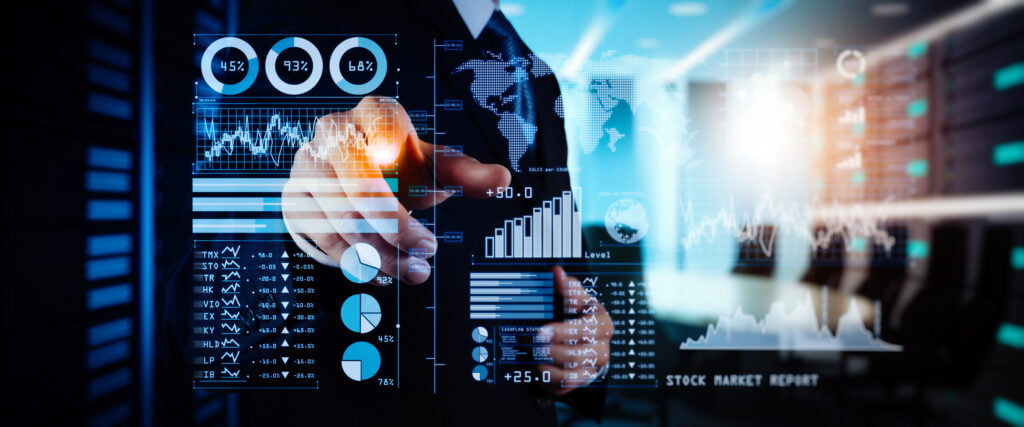In the ever-evolving landscape of technology, businesses are continuously seeking ways to gain a competitive edge and operate more efficiently. Two prominent tech trends that have risen to the forefront of this quest are Artificial Intelligence (AI) and Business Intelligence (BI). When these two forces join hands, they create a powerful toolkit for businesses. This article delves into the synergy between AI and BI and how it’s reshaping the way companies make decisions and grow.
Understanding the Basics: What Are AI and BI?
Before we dive into the intricacies of their convergence, let’s break down what AI and BI entail.
What is Artificial Intelligence (AI)?
Artificial Intelligence represents the machines and systems that mimic cognitive functions associated with the human mind, such as learning, problem-solving, and pattern recognition. AI can process large amounts of data and perform tasks that typically require human intelligence, only at a much faster rate.
What is Business Intelligence (BI)?
Business Intelligence, on the other hand, involves analyzing business data to provide actionable insights. BI tools aggregate, analyze, and present business information to help companies make informed decisions. It’s the backbone of a data-driven strategy, providing clarity and support to decision-making processes.
The Marriage of AI and BI: A New Era for Data Analysis
When AI meets BI, the result is a dynamic duo that can transform data analysis and business processes.
How AI Enhances BI
AI technologies, like machine learning and natural language processing, can greatly enhance BI capabilities. AI can sift through massive datasets much more quickly than traditional methods, identifying trends and patterns that might go unnoticed by human analysts.
BI Infused with AI: Smarter Analytics
Infusing BI with AI leads to smarter analytics. Predictive analytics, for instance, uses AI to forecast future trends based on historical data, giving businesses foresight that can be critical for strategic planning.

The Impact of AI on Business Intelligence
The intersection of AI and BI is leading to groundbreaking developments in the way we handle business data.
Real-Time Data Processing with AI and BI
AI’s real-time processing capabilities combined with BI tools mean that businesses can analyze and act upon data as it’s being generated. This immediacy can be a game-changer in industries where timing is crucial, such as finance or e-commerce.
Enhanced Decision-Making with AI-Powered BI
With AI-powered BI, businesses can achieve a higher level of accuracy in their decision-making processes. This precision stems from AI’s ability to learn from data over time, fine-tuning its analytical models for better predictions and recommendations.
AI’s Role in Predictive and Prescriptive Analytics
AI is transforming predictive and prescriptive analytics within BI, enabling businesses to not only forecast outcomes but also suggest the best course of action.
Predictive Analytics: Forecasting the Future
Predictive analytics leverages AI to identify the likelihood of future outcomes based on historical data. This foresight can inform everything from marketing campaigns to inventory management.
Prescriptive Analytics: Guiding Decision-Makers
Prescriptive analytics goes a step further by not just predicting outcomes but also recommending actions. AI algorithms can suggest the best strategies to achieve desired business objectives, essentially guiding decision-makers through a data-driven path.

AI-Driven Data Visualization: Seeing Is Believing
Data visualization is a critical component of BI, and AI is enhancing this aspect as well.
The Evolution of Data Visualization
AI-driven data visualization tools can automatically generate graphs and charts that best represent the underlying data patterns, making complex data more accessible and understandable for business stakeholders.
Interactive Data Exploration
Interactive data exploration, powered by AI, allows users to engage with data more intuitively. Users can ask questions and explore data through conversational interfaces, making data insights more accessible to all levels of business users.
AI and BI in Action: Case Studies
It’s one thing to discuss the potential of AI and BI, but seeing them in action brings their impact to life.
Retail Industry: Personalized Customer Experiences
In retail, AI and BI work together to create personalized shopping experiences. By analyzing customer data, businesses can tailor product recommendations and marketing efforts to individual consumer preferences.
Healthcare Sector: Improving Patient Outcomes
The healthcare sector utilizes AI and BI for better patient outcomes. By analyzing patient data, these technologies can identify risk factors and suggest preventative measures or treatments, leading to more effective healthcare delivery.
Challenges and Considerations: The AI-BI Integration
While the benefits are plentiful, integrating AI with BI does not come without its challenges.
Data Privacy and Security
One of the most significant concerns is data privacy and security. As businesses collect and analyze more data, they must ensure that they’re protecting sensitive information and complying with regulations.
The Skills Gap
There’s also a skills gap to consider. Not all businesses have the in-house expertise to leverage AI and BI effectively. Investing in training or hiring specialists can be a hurdle for some companies.

Future Trends: Where AI and BI Are Headed
As we look to the future, certain trends are shaping the trajectory of AI and BI.
The Rise of Automated Insights
Automated insights are becoming more prevalent, with AI systems not only analyzing data but also highlighting key insights without human intervention.
Democratization of Data
The democratization of data, where business intelligence becomes accessible to all levels of an organization, is another trend to watch. AI is playing a significant role in making this possible.
Conclusion: Embracing the AI-BI Synergy
The convergence of AI and BI is undeniably reshaping the business world. Companies that harness the power of these two technologies can expect to enjoy improved decision-making, enhanced efficiencies, and a significant competitive advantage. As we advance, the symbiotic relationship between AI and BI will only grow stronger, paving the way for more innovative solutions and transformative business strategies.
Given the universal applicability of data analysis, it’s hard to imagine any industry remaining unaffected by AI and BI. All sectors can find value in better data insights.
Companies can ensure ethical AI use by establishing clear policies, maintaining transparency in their AI-driven decisions, and staying informed about ethical guidelines and regulations in their industry.
Small businesses can use AI and BI to better understand their customers, optimize their operations, and make data-driven decisions that can lead to growth and improved competitiveness.
AI and BI integration can lead to the evolution of job roles, with a greater emphasis on data literacy across the board. It might also create new roles focused on data science and analytics.
Common tools include data analytics platforms like Tableau, Power BI, and Qlik, which are increasingly incorporating AI functionalities to improve their services.




